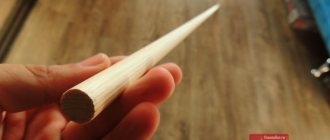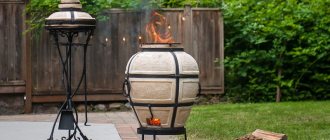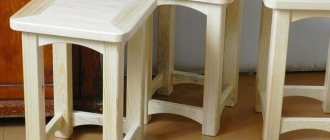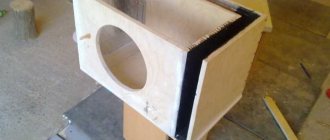When clearing or sanitizing a summer cottage, you have to uproot the stumps, that is, remove them along with the roots.
At the same time, for various reasons, it is impossible to use self-propelled equipment, so you have to use available equipment and tools, as well as your own muscular strength.
More information about:
- reasons why it is necessary to uproot stumps;
- main types of uprooting;
- types of root systems
you will find in this article. Here we will tell you how to uproot stumps and trees in your garden with your own hands.
Is it easy to uproot trees on your property by hand?
Uprooting stumps by hand is very hard work , because you have to:
- dig the ground with a shovel;
- loosen it with a crowbar or pickaxe;
- chop thick vibrating roots with an ax;
- pull out the stump using a lever (if you don’t have a hoist or winch at hand).
Therefore, only a healthy and strong person with the necessary skills should uproot stumps. If it is not possible to involve such a person in uprooting, then it is better to contact a specialized organization that provides such services.
The cost of their work depends on many factors, but on average it is 20–100 rubles per 1 cm of stump diameter.
DIY devices
The uprooters that are offered by stores and manufacturers of such equipment do not always meet the expectations of buyers in terms of their characteristics or price, so often, instead of purchasing the uprooter, they make it themselves .
A well-proven model is taken as a basis and adapted to a specific technique or conditions of use, then embodied in metal. However, there are homemade products that do not have commercially produced analogues.
We have prepared a list of forums where various questions about homemade uprooters are discussed:
- DIY;
- Farmer Ru.
Basic Tools
For manual uprooting, the following tools are required :
- shovels and bayonet shovels;
- axe;
- wood saw or chainsaw;
- scrap;
- pick;
- pin;
- sledgehammer;
- winch or hoist;
- wide nylon belt;
- steel rope.
These tools will be needed for any type of manual uprooting, so it is advisable to start work on the site by purchasing them.
Most tools are available at your local hardware or hardware store, and the pin can be made from steel reinforcement with a diameter of 15–25 mm .
To do this, you will need a piece of reinforcement 1–1.5 m long (the softer the soil, the longer the pin should be), one end of which is sharpened with a grinder at an angle of 20–45 degrees, and on the other a round heel made of sheet steel with a thickness of 10 and a diameter of 50 is welded. mm.
Weed extractor manufacturing technology
A device made with your own hands will be reliable and durable. So, you can get rid of not only the top part of the weeds, but also their roots. So, to make a weed extractor, you will need a tubular body, which will have a cutting part made in the form of a groove with sharp edges. On the opposite side, a wooden handle will be inserted into the weed extractor, which will be secured with a screw through a hole in the metal.
Materials and tools
Such a device can be made from a piece of pipe having a diameter of 25–40 mm. You can use a piece of the handle as a handle. Tools you will need:
- Drill with drill bit.
- Grinder with cutting disc.
- Measuring square.
- Files.
- Sandpaper.
- Plane.
- Screwdriver.
Manufacturing procedure
Now let's start the technological process. To get started, check out the weed extractor layout diagram. This will help you accurately determine the size and shape of the device, as a result of which the process of making the uprooter will be easier and faster.
Work order:
- According to the drawing, mark the steel tube and cut it to the length and shape of the drawing.
- First, secure the tube and use a grinder to make 2 longitudinal cuts. Excess metal can be removed with a transverse oblique cut.
- Now cut the end of the gutter at a 35º angle.
- Remove burrs with a file.
- Sharpen the working part of the tool from the inside. Finish the lower edge with a semicircular file.
- Now drill a hole for a screw to attach the handle. Sand the root remover with sandpaper.
- And at the last stage, insert the handle into the uprooter and tighten the screw.
This device will allow you to remove weeds, leaving the roots of the cultivated plants intact and without destroying nearby layers of earth.
To remove a weed, stick the uprooter into the ground near the root of the plant, loosen the soil around it, slightly turning the tool towards and away from you. Then slightly lift the plant with the soil using the extractor and remove it from the ground with your hand.
Types of manual wood removal
When manually removing wood, the following types of uprooting are used:
- removal of a stump with lateral roots;
- removing a stump without roots;
- removal of thick roots.
The main difference between manual uprooting and mechanized uprooting is the limited possibilities for influencing the stump and roots, so it is rarely used for complete removal of roots .
After all, many trees have upper roots that stretch for tens of meters, and their thickness often exceeds 5 cm.
To remove roots, you have to dig not only a hole around the trunk , but also dig a trench around each root , so it’s easier to hire a tractor to quickly do this work.
With lateral roots
This uprooting method is used where some other plant needs to be planted instead of a healthy tree that has been cut down . For example, when expanding a site, it is necessary to cut down the trees enclosing it, which protected the soil from air erosion and improved the water regime of the soil.
If a diseased tree is removed, then the following type of uprooting must be used, because it allows not only to remove the root system, but also to destroy the causative agents of root rot and other diseases.
Here is the procedure that needs to be carried out for such uprooting:
- Draw a circle around the stump, the diameter of which is 10 times larger than the diameter of the trunk near the ground, but not less than 1 m.
- Dig all the soil up to the top lateral and horizontal roots. Dig them from all sides.
- Use an ax to chop off the roots near the trunk and as far away from it as possible. Be careful - you need to place your feet so that the ax that jumps off the wood does not cause injury to you. If the lateral roots are too thick, then you need to dig them up so that there is 5–10 cm between them and the ground, then cut them with a hacksaw or chainsaw. When working with a chainsaw, remember that even a small piece of earth, if it gets under the chain, greatly dulls it.
- Dig a hole in the same way until its depth reaches five times the diameter of the trunk, but not less than 1.5 times the depth of the hole required for planting a new tree.
- Shake the stump, if it elastically moves 2–3 cm or more, then you have removed all horizontal and lateral roots, so it can be trimmed. If it stands rigidly and can only be moved a few mm, it means that there are several more rows of horizontal or even lateral roots. In most cases, the stump of even a healthy tree, the main root of which is cut down at such a depth, no longer produces shoots, but there are exceptions. Therefore, it is necessary to decide what to do next: go deeper to remove the lateral roots, cut down the vertical root and remove the stump, hoping that it will not sprout anymore, or cut down the vertical root and burn the root system remaining in the ground to ensure that shoots do not grow.
- Cut the main root as close to the ground as possible. If you can’t cut it, try tilting the stump with a crowbar and cutting from the bend side.
- If there is no main root, then dig up the bottom row of lateral roots and cut them off at the maximum distance from the root. Then insert a crowbar under them and turn out the stump.
Features of using crowbar and winch or hoist
Instead of a crowbar for uprooting, you can use a winch with a force of 3–6 tons .
At a distance of 5–10 m from the stump, drive a pin into the ground, leaving 10 cm on the surface, including the heel, then attach a winch to it, and connect the second edge of the winch to a steel loop, which you throw over the stump.
Tighten the loop and pull the winch , while watching the position of the pin. If the roots are dug up and not cut off enough, the pin will come out of the ground.
After removing the stump, pull the pin out of the ground; to do this, place a crowbar and a couple of bricks or a board of suitable thickness under it.
The crowbar forms a lever, the short arm of which is located between the support and the heel, and the long one between the heel and the hands. Raise the crowbar and it will pull the pin out of the ground. This lifting is done from different sides, gradually increasing the height of the lining.
If for some reason it is not possible to use a pin, the winch can be attached to a live tree .
Please observe the following conditions :
- use a tree whose diameter exceeds the diameter of the stump by at least 1.5 times;
- choose only a healthy tree without rot and disease;
- attach the winch to the tree only with a wide nylon, woven or leather belt, for example, from a safety belt;
- attach the winch to the tree as close to the ground as possible, and place the loop on the stump as high as possible.
We root without removing roots
This uprooting method is used only for stumps with a diameter of 10 cm or less , remaining after cutting young trees with superficial or tap root systems .
This method is not suitable for trees with a fibrous root system (birch, apple and others).
It is more effective in cases where, after removing a stump, it is necessary to burn off the remains.
The method is also advisable if you plan to plant bushes with a shallow root system in place of this stump.
Here's the procedure :
- follow steps 1–2 of the previous uprooting method;
- Having reached the horizontal roots, dig them up so that you can chop them off approximately half the distance to the edge of the hole;
- near the cutting site, drive the crowbar under the root and slightly lift it, this will reduce the loss of ax energy caused by vibration upon impact;
- cut off all large and small roots;
- remove the stump with a crowbar or winch as described above.
Elimination of thick roots
After removing the stump, the roots located outside the hole remain.
In most cases, all life processes in them cease and, with sufficient moisture, they rot in 15–30 years.
If the tree has been infected with pathogens, or these roots interfere with construction/repair work, then they are removed in one of the following ways :
- They dig up and cut down the interfering area - this method is applicable to surface roots if they interfere with construction or repairs.
- Poisoned with potassium or ammonium nitrate - this method is suitable for removing diseased roots of any type. After all, saltpeter changes any organic matter, including pathogens, after which they lose their harmful properties. We talked about this method in more detail here.
Most popular models
Uprooters are produced both as attachments for various tractors, and as fully equipped uprooting machines , equipped with a front uprooter-collector and a rear ripper.
We have prepared a review of the most popular models of attachments and uprooting machines, based on the number of search queries on the Internet.
KS-08.00.000
This model of uprooter-gatherer is a modern version of the obsolete and discontinued M-6 uprooter machine.
Designed for installation on all modifications of the DT-75 tractor. KS-08.00.000 is equipped with two lifting hydraulic cylinders (completely similar to those installed on bulldozer buckets) and two lever mechanism hydraulic cylinders.
Overall dimensions - 250 x 93 cm (width and height), weight - 850 kg. Suitable for uprooting bushes, small forests and stumps with a diameter of no more than 30 cm. Can turn stones weighing 3 tons out of the ground. The maximum depth at which the fangs effectively hook roots or stones is 35 cm.
KT-01
This uprooter-gatherer appeared as a result of the development and modernization road-building machine, popular in the USSR, based on the T-170 medium tractor.
It is produced both as a tractor with appropriate attachments, and separately. For installation on tractors T-10, T-130 and T-170, standard mounting points are used . The dimensions of this equipment are 325 x 150 cm (width and height), weight - 2.8 tons, maximum depth of fangs - 50 cm.
B14.6020EN
The bulldozer ChTZ B12 is produced under this number , equipped with a standard blade and a rear single-tooth ripper 12N.
Thanks to its enormous weight (23–25 tons, depending on the modification) and powerful motor (YaMZ-236B-4, 215 hp), it can uproot stumps with a diameter of 1 m, as well as pull out roots 15–25 cm thick.
You can install any other attachments on the bulldozer that are suitable for this model or analogues, because it is equipped with standard fasteners .
R 1100
The mounted uprooter is designed for installation on excavators weighing more than 10 tons .
It is used to remove small stumps, and the heavier the excavator, the larger the stump it can remove.
The effect of the lifting lever is insignificant due to the incorrect ratio of the length of the arms, so the entire load falls on the hydraulic cylinders of the manipulator.
The advantage of this model is the ability to catch roots at a depth that is inaccessible to front- or rear-mounted rippers.
Important Points and Precautions
There are several rules that apply to the manual uprooting method. Next we will look at the most significant of them.
Who can carry out such work?
This is very hard physical work, involving enormous loads.
Trust uprooting only to physically strong men .
Otherwise, short-term overload or prolonged stress can lead to a hypertensive crisis and other health problems.
Removing wood debris from dry soil
To uproot a stump from dry soil, water the soil around it 1-2 times a week for a month . Pour out 2-4 buckets of water, which will allow the moisture to penetrate even into the deep layers of the soil and make them softer.
To improve the water supply to deep layers, use a pick or crowbar to make 5–15 holes 10–20 cm deep in the ground around the tree. Thanks to this, during irrigation, more water will reach the deeper layers of the soil.
Features of using a winch
Be careful with a winch or hoist - if you attach them incorrectly to a living tree, the tree may become sick or die due to damage to the bark.
In addition, core rot in the first years does not manifest itself externally, but a powerful lateral force from the hoist can break it.
Even a healthy tree will hurt due to the disruption of the soil structure around the roots if there is too much lateral load, so after uprooting, water it generously with water . Excess moisture will make the soil mobile, and the soil will fill all the resulting voids.
Features of work performed near buildings
If you need to remove a stump near your house, use a chemical method, because manual removal leads to slight soil movements , which causes small voids to form under the foundation. In combination with frost heaving, this can lead to a fracture of the foundation and cracking of the walls.
In what weather should you uproot the remaining trees?
Uproot stumps only on dry, windless days . Do not work in the rain - slippery ground increases the risk of falling and injury.
Do not work during strong winds - pieces of earth or wood debris may get into your eyes.
Also, you should not uproot in the dark - an ax, crowbar and shovel in poor visibility conditions can cause serious injuries.
Be careful when working with any tool , do not cause injury to yourself, assistants or those who happen to be nearby.
Conclusion
Manual uprooting of stumps is hard work, the result of which largely depends on the correct algorithm of actions .
After reading the article, you learned:
- what methods of manual uprooting are there;
- how to uproot trees with different types of root systems manually in a country house or garden;
- what rules must be followed to effectively and safely remove stumps.
If you are an experienced summer resident, then you probably know what weeds are, because every year you have to fight them. The simplest method of getting rid of weeds is hand weeding. Removing plants with strong root systems is much easier when using a hand puller.
In this article you will learn how to make your own weed extractor. The article will discuss the types of uprooters, and will also offer 2 options for making a manual weed remover yourself.
What can you do with an uprooted stump?
The butt and roots are made of wood, so you can use them to make :
- wood chips;
- fuel briquettes;
- firewood;
- furniture;
- crafts.
More detailed information about the use of uprooted and in-ground stumps, as well as methods for working with this material, can be found here (use of stumps).
Rooters for MTZ tractors
Tractors from the Minsk Motor Plant are extremely popular due to the combination of high performance characteristics and a large selection of various attachments.
However, due to the design features (too high movement speed and low traction force), they are not suitable for working with rippers or collectors, so only different versions of shredders are installed on them.
All these devices are called uprooters, which is why confusion arises, because when searching for an uprooter for MTZ, the user means shredders.
Even after installing a hydraulic speed reducer, the tractor cannot create sufficient traction force necessary to work with rippers or collectors. This is due both to the design features of the hydraulic creeper and the small contact area of the wheels with the ground.
Therefore, real uprooters, that is, rippers and collectors, are installed only on tracked vehicles , which create sufficient traction force at extremely low speeds.
Biological method: how mushrooms will destroy a stump
Nature itself will help you get rid of unwanted objects on your site if you help it. The use of mushrooms is not so popular in the destruction of stumps, but it is very effective. In addition, you can provide yourself with fresh, delicious mushrooms.
Make several deep cuts around the perimeter of the stump and fill them with the mycelium of mushrooms, for example, honey mushrooms or oyster mushrooms. You can buy it at a gardening store or order it online. The mushrooms will grow quickly enough, using wood to feed the mycelium and thereby destroying the stump along with the roots.
Mushrooms planted on a stump will cope with old wood in 2–3 years
This method cannot be called fast. A small stump will collapse in a year, a more massive one will take 2-3 years. But it is environmentally friendly, and if you are not in a hurry, over the years you will learn how to grow mushrooms, and, perhaps, over time, turn it into your own small business. Or learn new mushroom dishes. In any case, the benefits are obvious.
What are the pros and cons of the “mushroom” method - table
| Advantages | Flaws |
| A completely biological process without the use of chemicals, which does not require significant effort and financial costs. | The duration of the process, which can take 2–3 years. |
| Grown mushrooms can be eaten. | It is dangerous by infecting other trees growing nearby with mycelium. |
Now you can independently choose the stump removal method that is most suitable for you and your garden. In this case, it is necessary to take into account such factors as the speed and cost of the method, advantages and disadvantages. But by making the right choice, you will save your summer cottage plot and the fertile soil on it.











